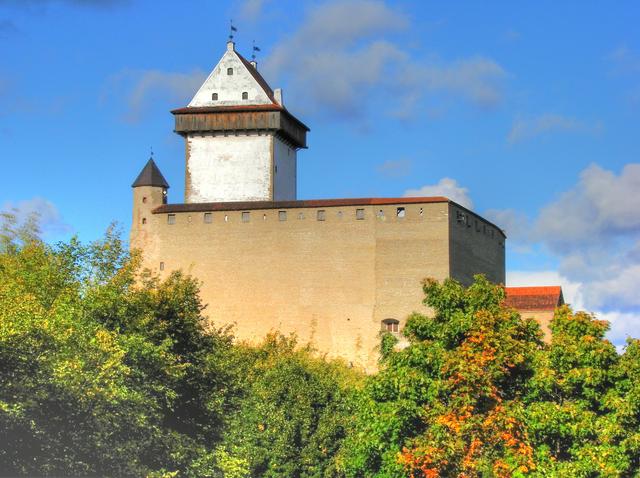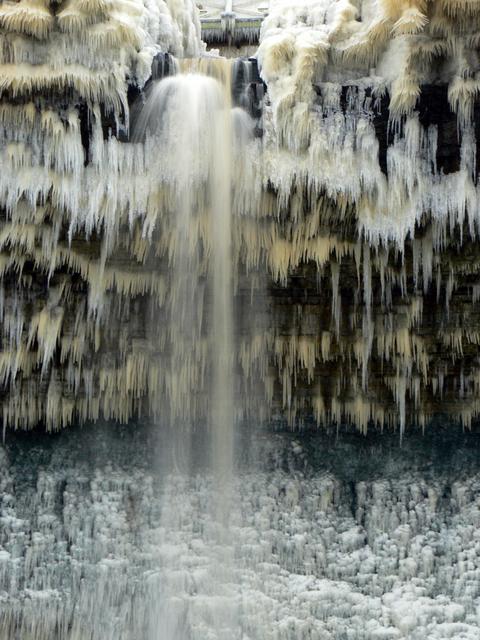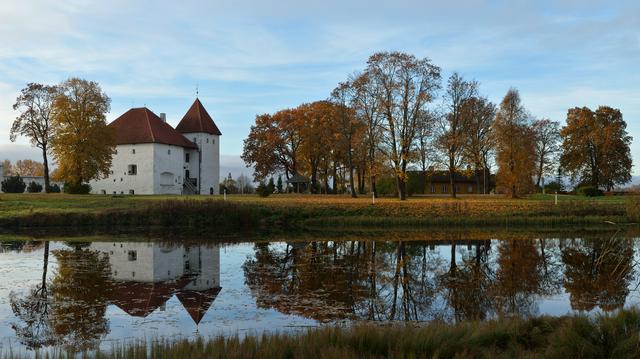East Estonia or Ida-Viru county is in north-eastern Estonia, on the border with Russia.

- Narva. – Estonia's eastern-most and third largest city, on the Narva River, which is the border with Russia. Famous for the Hermann castle, right opposite of the Ivangorod's castle, and the Kreenholm factories. Even though it might seem grey and dull.
- Narva-Jõesuu. – The beach side town on the Narva River near Narva.
- Jõhvi. – The capital of the county, but rather uninteresting from a travellers point of view.
- Sillamäe. – A beautiful coastal town in the east and formerly closed city with the best ensemble of Stalinist architecture in the entire Baltics. Built after the war with an uranium processing plant, successfully redesigned after Estonia's independence.
- Mustvee. – A cozy fishing village at Lake Peipsi.
- Toila. – A small coastal and historic resort town.
- Kohtla-Järve. – A large concentration of industrial settlements with Soviet architecture, and inter-war architecture of the independent Estonia. Also, a quite unique Orthodox church of the 1930s, in the style of Cubism, and a shale mine and museum in the nearby Kukruse village.
- Kuremäe. – Contains the famous Pukhitsa convent/nunnery, the only Orthodox monastery in the whole of Estonia.
- Püssi. – A poor but now recovering town with an interesting artificial mountain made of ash from its oil shale power plant, which has been depositing ash in the location since the 1930s.
Narva. – Estonia's eastern-most and third largest city, on the Narva River, which is the border with Russia. Famous for the Hermann castle, right opposite of the [[Ivangorod]]'s castle, and the Kreenholm factories. Even though it might seem grey and dull.
Narva-Jõesuu. – The beach side town on the Narva River near Narva.
Jõhvi. – The capital of the county, but rather uninteresting from a travellers point of view.
Sillamäe. – A beautiful coastal town in the east and formerly closed city with the best ensemble of Stalinist architecture in the entire Baltics. Built after the war with an uranium processing plant, successfully redesigned after Estonia's independence.
Mustvee. – A cozy fishing village at Lake Peipsi.
Toila. – A small coastal and historic resort town.
Kohtla-Järve. – A large concentration of industrial settlements with Soviet architecture, and inter-war architecture of the independent Estonia. Also, a quite unique Orthodox church of the 1930s, in the style of Cubism, and a shale mine and museum in the nearby Kukruse village.
Kuremäe. – Contains the famous Pukhitsa convent/nunnery, the only Orthodox monastery in the whole of Estonia.
Püssi. – A poor but now recovering town with an interesting artificial mountain made of ash from its oil shale power plant, which has been depositing ash in the location since the 1930s.
- Kurtna. A lake district with a pre-revolution manor in Kurtna village, and east of it a forest and lake area with well done touristy hiking trails.
Kurtna. A lake district with a pre-revolution manor in Kurtna village, and east of it a forest and lake area with well done touristy hiking trails.
East Estonia corresponds to the Ida-Viru county. This region includes the far eastern Estonia between the shores of the Baltic Sea and Lake Peipsi. Russians make up 71% of the population and Estonians 20%. There are relatively few historic sights here, but, unusual for Estonia, many Soviet architectural and industrial remains of varying degrees of abandonment.
Lake Peipsi is located between Russia and Estonia, and the fourth largest lake in Europe. It is nice for swimming at the beautiful dune beaches on its northern side. The rest of the lake is mostly a swamp. The tourism of the lake's northern side is relatively developed – free campsites, very well maintained, and overlooking the beach. On weekends in summer, many Estonians put up their campsites around the lake.

- Valaste Waterfall. The Valaste waterfall is most impressive in early spring; then, the winter snow is melting and volume of cascading water is greatest. During winter the waterfall freezes and forms fairy-tale like ice sculptures. In 1997, a platform for tourists was built opposite the waterfall. There is a car park, some explanatory signs and a trail using a double spiral staircase to get down the cliff.
- Northern coast of Lake Peipsi. Quiet and remote. Optimal in summer when the Baltic Sea is overrun by tourist.
Valaste Waterfall. The Valaste waterfall is most impressive in early spring; then, the winter snow is melting and volume of cascading water is greatest. During winter the waterfall freezes and forms fairy-tale like ice sculptures. In 1997, a platform for tourists was built opposite the waterfall. There is a car park, some explanatory signs and a trail using a double spiral staircase to get down the cliff.
Northern coast of Lake Peipsi. Quiet and remote. Optimal in summer when the Baltic Sea is overrun by tourist.
- Shale mines and museum, Lehe 10a, Kukruse, +372 3321353, +372 53359080. Tu–F 10–18:00, Sa 10–16:00. An interesting exhibition about the origin of the oil shale, the history of its extraction and its modern use. All this fits in one large hall, many stands of which have remained since Soviet times and are cute handwritten inscriptions. The second hall is hung with paintings showing the work of miners and other workers in the oil shale industry. It might seem naive, but still nice. Do not miss to talk to the caretakers – they are happy to tell about the past and present of Kohtla-Järve. €2 (2013).
- Shale mines and museum, Kohtla-Nõmme, +372 3324017. 11–19:00.
- Ash Mountain. The highest ash mountain in the Baltic. The ash is from a oil shale power plant, which has been depositing ash here since the 1930s. Nowadays, the mountain is used for motocross.
- The grave of Kalevipoeg. The legendary hero of the Estonian epic poetry fought somewhere in these local forests. There was a rumour that in the tomb of Kalevipoeg unimaginable treasures are hidden. So, cunning seekers turn over a lot of soil in the surrounding forests and thereby damaging the Iron Age burials. So, the actual grave is probably lost forever. Hence, on one of these places and a symbolic stone was.
Shale mines and museum, Lehe 10a, Kukruse, +372 3321353, +372 53359080. Tu–F 10–18:00, Sa 10–16:00. An interesting exhibition about the origin of the oil shale, the history of its extraction and its modern use. All this fits in one large hall, many stands of which have remained since Soviet times and are cute handwritten inscriptions. The second hall is hung with paintings showing the work of miners and other workers in the oil shale industry. It might seem naive, but still nice. Do not miss to talk to the caretakers – they are happy to tell about the past and present of Kohtla-Järve. €2 (2013).
Shale mines and museum, Kohtla-Nõmme, +372 3324017. 11–19:00.
Ash Mountain. The highest ash mountain in the Baltic. The ash is from a oil shale power plant, which has been depositing ash here since the 1930s. Nowadays, the mountain is used for motocross.
The grave of Kalevipoeg. The legendary hero of the Estonian epic poetry fought somewhere in these local forests. There was a rumour that in the tomb of Kalevipoeg unimaginable treasures are hidden. So, cunning seekers turn over a lot of soil in the surrounding forests and thereby damaging the Iron Age burials. So, the actual grave is probably lost forever. Hence, on one of these places and a symbolic stone was.

- Purtse Castle. Summer: M–Th 11–20:00, F–Sa 11–21:00, Su 11–18:00; Winter: only on weekends. Unlike all other neighbourhoods, this castle really deserves your visit. Built in 1421, the manor was turned into a real castle in 1533. It belonged, besides others, to Henrik Fleming, Jacob von Thauve – who the castle, Berend von Tobe, and Jacob de la Gardi. The castle was burned and consequently rebuilt several times. During the Northern War, some of its towers were destroyed. Afterwards, it became property of the von Stackelbergs, who combined it with the Püssi manor. After Estonia's independence, the castle became public property, but was destroyed by the 1950s. Between 1987-1990, under the guidance of Madi Nappa, the architect of Inna Comoni and doctor of the University of Turku Willem Raam, the ancient building was fully restored. And in 1991, it was recognized as the best Estonian building.For visiting there are two floors available with stone stairs and rather unremarkable interior. The atmospheric restaurant on the ground floor serves original dishes in a medieval style. Quite unexpectedly exquisite for such a remote location, and thus not inexpensive (€5-6 per soup, ~€15 for hot dishes). FB. €1.
- Maidla Manor, Mõisa 1, Maidla (Located in the village of the same name, south of Kiviõli. Reached by bus, car, or even on foot from Kiviõli if you long to go by Maidla road.. The village itself is also very old, first mentioned in 1241. However, the only evidence of it is the manor. Although, the first mentioning of the manor dates back to 1465, the present Baroque building was erected between 1764-1767 by the architect Djurshmidta (Durschmidt). Since 1925, it has been operated as a school. So, it is not worth to get inside. But take pictures from the outside unlimitedly – the building is very beautiful.
- Erra Manor, Puiestee 13, Erra (Located in the village of Erra just north of Kiviõli, by foot or by car.. This manor was built in 1547 and belonged first to the von Essen, and afterwards to the von Courcelles. In the 1980s/1990s, the building was completely destroyed and looted. Now, only dull ruins remains.
- Püssi Manor, Kiviõli tee 23, Lüganuse. The majestic manor is now also owned by the Luganuse School. It consists of two houses formerly for farm labourers, a court house, a barn and a distillery. In addition, there is a small museum in the manor, dedicated to the history of its educational background, which began in the 1920s.
- Iluka Manor, Illuka (on the road from Jõhvi, 5 km before Kuremäe, +372 5212469, +372 5189129. A large and beautiful manor house of the late 19th century with neo-Gothic elements.
- Pagari Manor, Pagari (12 km south of Jõhvi, on the way to Tartu. A pretty and preserved manor house mainly of wood; a barn, a cellar, the remains of a windmill, and a picturesque landscape park.
- Mäetaguse Manor, Pargi 2, Mäetaguse, +372 3366900. A classic manor house of the late 18th century turned into a country spa hotel.
- Kukruse Manor, Kukruse küla 20, Kukruse, +372 56876503, +372 53059902.
- Järve Castle.
Purtse Castle. Summer: M–Th 11–20:00, F–Sa 11–21:00, Su 11–18:00; Winter: only on weekends. Unlike all other neighbourhoods, this castle really deserves your visit. Built in 1421, the manor was turned into a real castle in 1533. It belonged, besides others, to Henrik Fleming, Jacob von Thauve – who the castle, Berend von Tobe, and Jacob de la Gardi. The castle was burned and consequently rebuilt several times. During the Northern War, some of its towers were destroyed. Afterwards, it became property of the von Stackelbergs, who combined it with the Püssi manor. After Estonia's independence, the castle became public property, but was destroyed by the 1950s. Between 1987-1990, under the guidance of Madi Nappa, the architect of Inna Comoni and doctor of the University of Turku Willem Raam, the ancient building was fully restored. And in 1991, it was recognized as the best Estonian building.For visiting there are two floors available with stone stairs and rather unremarkable interior. The atmospheric restaurant on the ground floor serves original dishes in a medieval style. Quite unexpectedly exquisite for such a remote location, and thus not inexpensive (€5-6 per soup, ~€15 for hot dishes). FB. €1.
Maidla Manor, Mõisa 1, Maidla (Located in the village of the same name, south of Kiviõli. Reached by bus, car, or even on foot from Kiviõli if you long to go by Maidla road.. The village itself is also very old, first mentioned in 1241. However, the only evidence of it is the manor. Although, the first mentioning of the manor dates back to 1465, the present Baroque building was erected between 1764-1767 by the architect Djurshmidta (Durschmidt). Since 1925, it has been operated as a school. So, it is not worth to get inside. But take pictures from the outside unlimitedly – the building is very beautiful.
Erra Manor, Puiestee 13, Erra (Located in the village of Erra just north of Kiviõli, by foot or by car.. This manor was built in 1547 and belonged first to the von Essen, and afterwards to the von Courcelles. In the 1980s/1990s, the building was completely destroyed and looted. Now, only dull ruins remains.
Püssi Manor, Kiviõli tee 23, Lüganuse. The majestic manor is now also owned by the Luganuse School. It consists of two houses formerly for farm labourers, a court house, a barn and a distillery. In addition, there is a small museum in the manor, dedicated to the history of its educational background, which began in the 1920s.
Iluka Manor, Illuka (on the road from Jõhvi, 5 km before Kuremäe, +372 5212469, +372 5189129. A large and beautiful manor house of the late 19th century with neo-Gothic elements.
Pagari Manor, Pagari (12 km south of Jõhvi, on the way to Tartu. A pretty and preserved manor house mainly of wood; a barn, a cellar, the remains of a windmill, and a picturesque landscape park.
Mäetaguse Manor, Pargi 2, Mäetaguse, +372 3366900. A classic manor house of the late 18th century turned into a country spa hotel.
Kukruse Manor, Kukruse küla 20, Kukruse, +372 56876503, +372 53059902.
Järve Castle.
- Beaches and resort towns of the northern coast of Lake Peipus and at the Baltic Sea
- Aidu Water Sports Centre. The former shale quarry has been transformed into an active recreation centre on the water, which includes a rowing channel for paid canoeing, the only such site in Estonian, independent rowing and diving. Everything must be ordered in advance. Sometimes, there are rowing competitions here.
Beaches and resort towns of the northern coast of Lake Peipus and at the Baltic Sea
Aidu Water Sports Centre. The former shale quarry has been transformed into an active recreation centre on the water, which includes a rowing channel for paid canoeing, the only such site in Estonian, independent rowing and diving. Everything must be ordered in advance. Sometimes, there are rowing competitions here.
The region is known for industrialisation, but also poverty, unemployment and abandoned properties, and a larger Russian population. Hence, keep track of your property, do not walk alone at night, and do not behave in any provocative way. Crime has increased slightly in the past.
- North Estonia – Famous for the financial centre of the country, Tallinn, and the Lahemaa National Park.
- South Estonia – Famous for the intellectual hub, ancient city and university town Tartu, and many picturesque town like Viljandi.
- Russia – Organised boat trips without visa into Saint Petersburg for up to three days are possible.
[[Russia]] – Organised boat trips without visa into [[Saint Petersburg]] for up to three days are possible.
